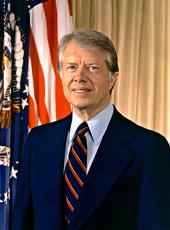
Stevenson-Wydler Technology Innovation Act of 1980 Statement on Signing S. 1250 Into Law.
I am pleased to sign S. 1250, the Stevenson-Wydler Technology Act.
Throughout this administration, I have been concerned with maintaining the strength of America's economy and the competitiveness of our industry. I have announced several initiatives addressing such vital national questions as productivity growth, innovation, trade development, new energy technologies, as well as specific programs for the steel, auto, textile, and shoe industries, which provide jobs for millions of Americans.
An essential element in each of these initiatives is an emphasis upon technological advancement, which is critical to increasing productivity and ensuring our long-term competitiveness.
The legislation I am signing today establishes a clear Federal mandate to promote industrial technology. It also offers an opportunity for enhanced government-business cooperation to achieve our national goals.
The Stevenson-Wydler Technology Innovation Act of 1980 is designed to foster a new era of government-industry cooperation. The best inventive minds from government, industry, and universities will work together at technology centers on innovative processes to increase productivity in a large number of industries. For example, they will investigate ways to make industrial machinery more efficient by reducing friction and improving .welding. Improvements in metal processing will increase productivity in every manufacturing industry, but especially in the automobile and business machine industries.
These technology centers can be established almost immediately after congressional approval of appropriations later this year. Although they will initially be funded jointly by government and industry, the centers are expected to become completely self-supporting within 5 years.
This legislation also establishes a Center .for the Utilization of Federal Technology (CUFT), which I called for in my industrial innovation message of last year. This center will be a clearinghouse for technological information—a one-stop shopping center for industries, universities, and State and local governments.
The Stevenson-Wydler Technology Act is of course only the first step in a major innovative effort.
We have much more to do in this crucial area, and currently the Congress is considering legislation that would reform our patent policy while encouraging industry to take the financial risks involved in developing inventions. We are also moving ahead to implement another recommendation-Corporations for Innovation and Development, to provide risk capital for start-up funding of new inventions. This program will involve State governments as well as the Federal Government, and during the past month we have contacted all 50 Governors to seek their participation in this program.
Improvements in technology and productivity are essential if our efforts to maintain a leading position in domestic and world markets are to succeed. To meet the challenges posed by an increasingly competitive world, we must marshal all the creative genius and all the vision we have available in government, industry, and labor.
Senator Stevenson and Congressman Wydler have shown such vision in producing this legislation. Their efforts were given bipartisan support by other Members of both Houses of Congress, notably Senator Cannon of Nevada, Congressman Brown of California, and Congressman Fuqua of Florida. I want to thank all of them for their hard work and leadership.
Note: As enacted, S. 1250 is Public Law 96480, approved October 21.
Jimmy Carter, Stevenson-Wydler Technology Innovation Act of 1980 Statement on Signing S. 1250 Into Law. Online by Gerhard Peters and John T. Woolley, The American Presidency Project https://www.presidency.ucsb.edu/node/251442
